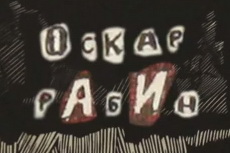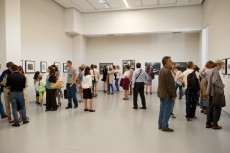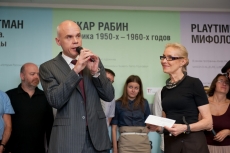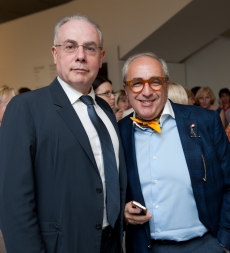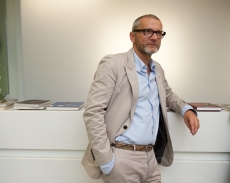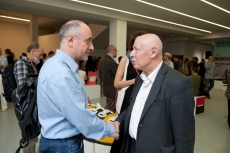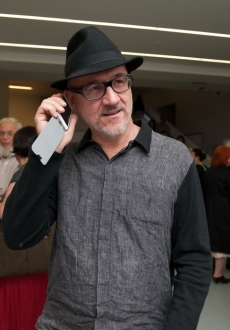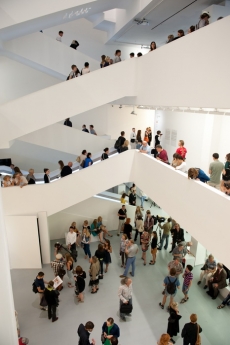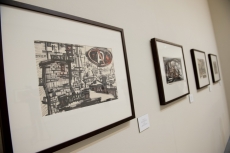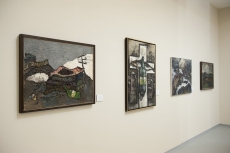Graphics. 1950s – 1960s
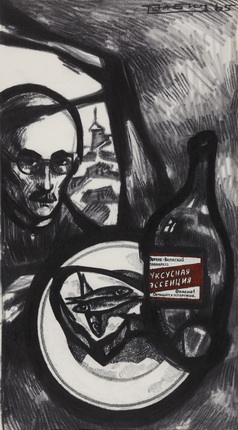
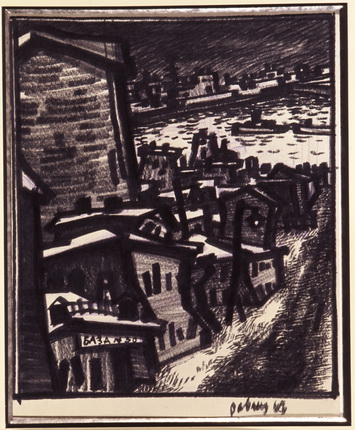
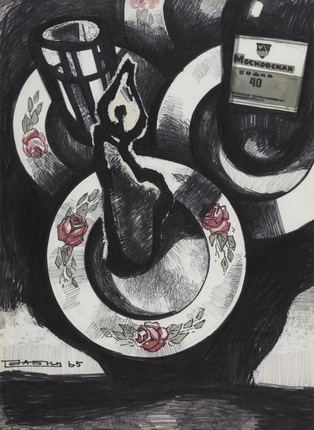
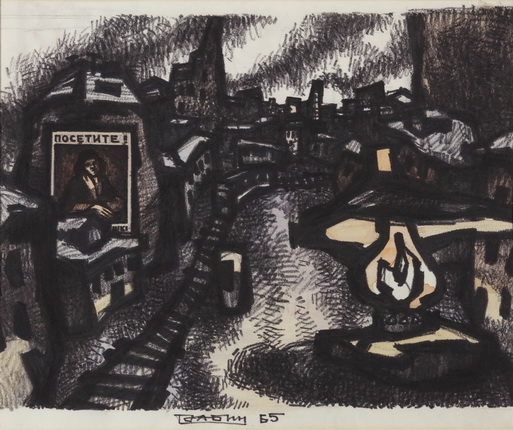
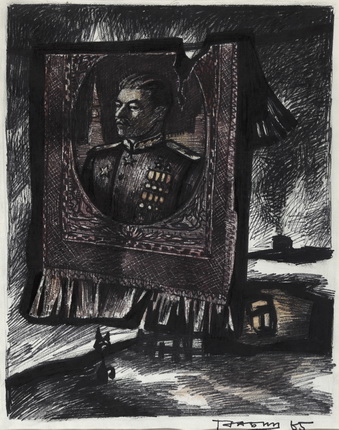
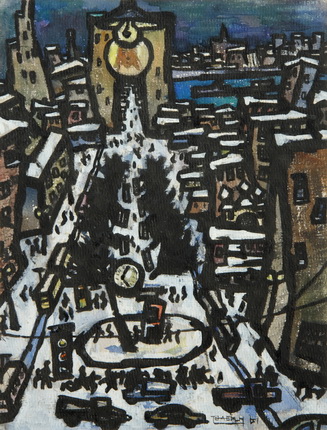
Oscar Rabin. Self-portrait with fish and vinegar essence. 1965. Paper, felt tip pen, Indian ink, watercolours. Collection of Alexander Kronik, Moscow
Oscar Rabin. Base No. 30. Nocturnal Moscow landscape. 1968. Paper, felt tip pen. Collection of Alexander Kronik, Moscow
Oscar Rabin. Still life with Moskovskaya vodka and candle. 1965. Paper, felt tip pen, watercolours. Collection of Alexander Kronik, Moscow
Oscar Rabin. Visit us! 1965. Paper, felt tip pen, watercolours. Collection of Alexander Kronik, Moscow
Oscar Rabin. Torn carpet with a portrait of Stalin. 1965. Paper, felt tip pen, watercolours. Collection of Alexander Kronik, Moscow
Oscar Rabin. Moscow. Trubnaya Square. 1961. Paper, watercolours. Collection of Alexander Kronik, Moscow
Moscow, 18.07.2013—8.09.2013
exhibition is over
Share with friends
The exhibition is timed to the 85th anniversary of the artist
For the press
MAMM celebrates the 85th birthday of Oscar Yakovlevich Rabin with the first exhibition of his early graphics. This eminent artist was a leading figure in the Soviet Nonconformist art movement and participant in the Lianozovo Group, as well as both initiator and organiser of the legendary ‘bulldozer exhibition’.
This exhibition includes graphic works from Alexander Kronik’s collection and paintings from the Tsukanov Family Foundation collection that relate to the earliest period of the artist’s work, from 1954 to 1966. A valuable contribution is provided by text commentaries to a number of the exhibits, written by Alexander Kronik from Rabin’s own words. Lengthy conversations between the artist and collector provide a clear indication of Rabin’s ‘voice’ and his quite early realisation not only of the artistic path he pursues to this day with the nobility of a true knight-in-arms, but also of a foreboding that predicted his destiny.
Oscar Rabin became a key figure in the history of Soviet Nonconformism, which acquired its defining features and took shape as a dynamic art movement after Nikita Khrushchev’s tragically infamous destruction of the Moscow Union of Artists’ Manezh exhibition in 1962. The so-called Nonconformists categorically refused to conform to Socialist Realism and were deliberately excluded as notoriously inimical, harmful elements stigmatised by the strange term ‘Formalists’. The artists Rabin, Nemukhin, Yankilevsky, Kabakov and Bulatov, Shteinberg (and many others) decided to make a complete break and went ‘underground’, subjecting themselves to almost laboratory conditions in a dark, chilly workshop (and some had none), from time to time uniting in creative groups motivated by friendship and personal relationships rather than artistic principles. One of the best defined was the so-called Lianozovo Group, which brought together several poets (G. Sapgir, I. Kholin, Ya. Satunovsky, etc.) and the artists O. Rabin, V. Nemukhin and L. Masterkova. A key figure for the ‘Lianozovites’ was artist and poet Yevgeny Kropivnitsky, whose daughter Valentina became the wife and faithful life companion of Oscar Rabin. The Lianozovites’ programmatic endeavour was to spurn the poeticising of reality in whatever form. Poets and artists used an emphatically terse language, and pictorial or poetic images were borrowed only from visible reality, the reality of barrack dwellings, a frugal diet, cheap vodka and never-ending human ennui like a foretaste of purgatory.
The 1950s to 60s marked an extremely interesting and important stage in Rabin’s creative activity. Representative of this period are his first works in the style of ‘Russian pop art’ with vodka, cards, road signs and directions, self-portraits, portraits of his wife Valentina Kropivnitskaya and artist friends, Lianozovo ‘landscapes’ with barracks — in short, it was then that Rabin determined his particular range of subject matter, gradually developing formal techniques which make him instantly recognisable. At this period Rabin’s fatal break with official Soviet art became obvious — his paintings and graphics clearly opposed the dominant canons of Socialist Realism. The authorities launched a persecution campaign against the artist in the press, beginning on 29 September 1960 with the article ‘The Devotees of ‘Rubbish Tip No. 8’’, published in Moskovsky Komsomolets. Featured in this exhibition are a graphic version of ‘Rubbish Tip No. 8’ and paintings that elicited the following response from one Soviet journalist: ‘Here is a gloomy, filth-strewn canvas... You see gnawed bones, some kind of revolting entanglement, a few black shoots. ...only after reading the bold inscription ‘Rubbish Tip No. 8’ do you learn the ‘idea’ and ‘content’ of this truly schizophrenic ‘canvas’.’
As a result of this campaign Rabin left the USSR and was stripped of Soviet citizenship; according to the artist himself, he spent his ‘third life in Paris’. Rabin’s official return to the context of Russian art occurred comparatively recently, and now after a full-scale retrospective at the State Tretyakov Gallery and several other exhibitions MAMM is delighted to present this more selective project that nonetheless shows visitors the ‘essence’ of Rabin’s work, allowing us to discern in sketches and finished graphic works what has made Rabin’s paintings the perfect symbol of this epoch. It seems there is no more apt description of Soviet reality than his ‘Passport’, ‘One Ruble’ and ‘Barracks with Moon’.
From 1965 onwards Rabin took part in exhibitions outside the USSR. Eric Estorick, owner of the Grosvenor Gallery, organised the first foreign exhibitions of Nonconformists in the 1960s, including Oscar Rabin’s first solo exhibition of 1965 in London. Eight of Rabin’s 1965 to 1966 drawings from Estorick’s collection were recently acquired by a Russian collector and returned to Moscow, and MAMM is pleased to present these works to the public for the first time.
www.svoykrug.com; www.tsukanovartcollection.com.
Author of commentaries: Alexander Kronik
Translation and text on Estorick: Ruth Estorick
1928 Born on 2 January, in Moscow.
1945-1947 Studies at the Academy of Arts in Riga.
1947 Returns to Moscow, studies at the V.I. Surikov Moscow State Art Institute.
1957 Participates in an exhibition of work by young artists at the 6th International Festival of Youth and Students in Moscow. Awarded an Honorary Diploma.
1964 First group exhibition abroad, at the Grosvenor Gallery (London, UK).
1965 First solo exhibition abroad, at the Grosvenor Gallery (London, UK).
1967 Begins his studies at the City Committee of Book, Graphic and Poster Artists. Participates in group exhibition organised by A. Glezer.
1974 Organiser and participant in the ‘bulldozer exhibition’ and exhibition at Izmailovo.
1975 Participates in an exhibition at the Apiculture Pavilion, Exhibition of Achievements of the National Economy.
1978 Journey to France, stripped of Soviet citizenship.
1986 Receives French citizenship.
2006 Presented with a Russian passport at the Russian Federation’s embassy in France by Ambassador A.A. Avdeev (subsequently RF Culture Minister).
2006 Laureate of the ‘Innovation’ State Prize for his creative contribution to the development of contemporary art.
2008 Receives the title Honoured Academician of the Russian Academy of Arts.
2013 Awarded the ‘For Service to Art’ medal by the Russian Academy of Arts.

